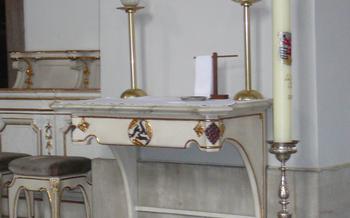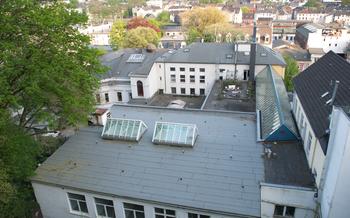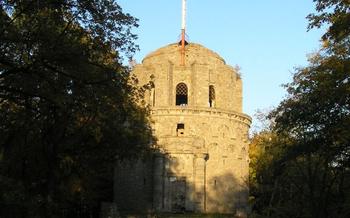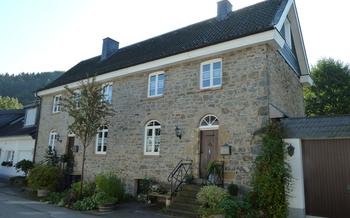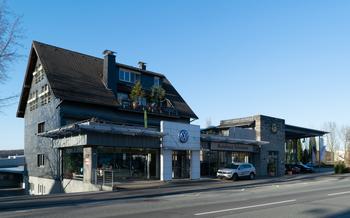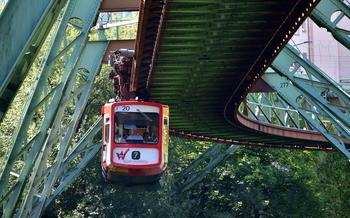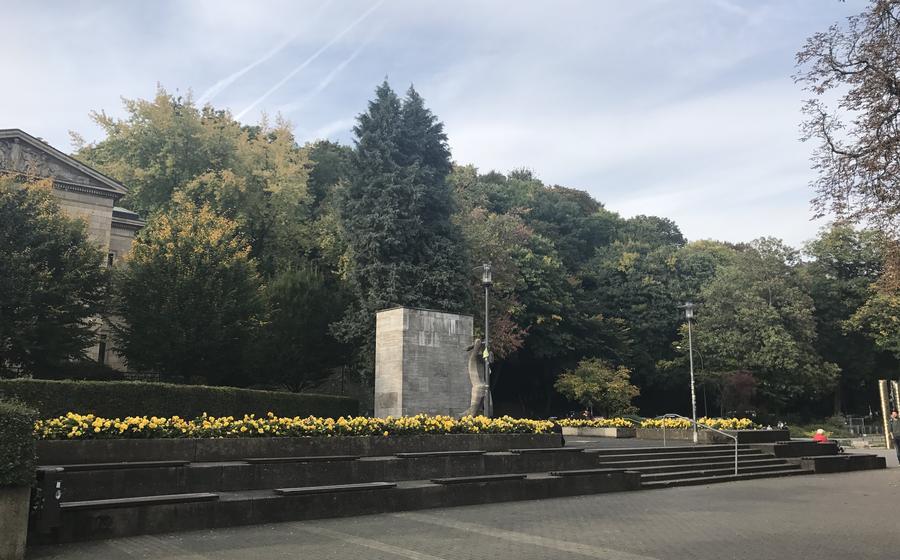
Deweerthscher Garten
- Historical Background
- Key Features and Highlights
- Flora and Fauna
- Opening Hours and Admission
- How to Get There
- Visitor Tips and Etiquette
- Best Time to Visit
- Nearby Attractions
- Photography Opportunities
- Accessibility Features
- Dining and Refreshments
- Family-Friendly Activities
- Guided Tours and Programs
- Insider Tip
Historical Background
The Deweerthscher Garten, also known as the Deweerth's Garden, is a stunning green oasis nestled in the heart of Wuppertal, Germany. Its history dates back to the late 19th century when the Deweerth family, prominent industrialists and art collectors, acquired the land and began transforming it into a private garden. Over the years, the garden evolved into a masterpiece of landscape architecture, showcasing a harmonious blend of natural beauty and artistic vision.
The Deweerth family played a pivotal role in shaping the garden's character. They commissioned renowned architects and gardeners to design and cultivate the grounds, resulting in a unique fusion of styles and influences. The garden's layout reflects the prevailing trends of the time, incorporating elements of Romanticism, Art Nouveau, and the Arts and Crafts movement.
The Deweerthscher Garten gained recognition not only for its aesthetic beauty but also for its cultural significance. It became a gathering place for intellectuals, artists, and social reformers, who sought inspiration and solace amidst its tranquil surroundings. The garden hosted numerous events, exhibitions, and gatherings, contributing to the vibrant cultural scene of Wuppertal.
Today, the Deweerthscher Garten stands as a testament to the Deweerth family's passion for horticulture and their commitment to preserving the city's green heritage. It remains a beloved destination for locals and tourists alike, offering a glimpse into the past while providing a serene escape from the bustling urban landscape.
Key Features and Highlights
The Deweerthscher Garten is a captivating tapestry of natural wonders and artistic expressions. As visitors stroll through the garden's meticulously landscaped paths, they will be greeted by a kaleidoscope of colorful blooms, each vying for attention amidst the verdant tapestry of nature. The rose garden, a fragrant haven, showcases a dazzling array of roses in vibrant hues, from the delicate blush of the 'Maiden's Blush' to the velvety crimson of the 'Black Baccara.'
At the heart of the garden, visitors will encounter a tranquil pond, its crystal-clear waters reflecting the surrounding foliage like a shimmering mirror. The pond provides a sanctuary for aquatic life, with elegant swans gliding gracefully across its surface and playful ducks dabbling in the shallows.
Interspersed throughout the garden are sculptures, each a testament to the creative spirit that permeates this enchanting space. From whimsical bronze figures to abstract stone creations, these sculptures add a touch of artistic flair and provoke contemplation among visitors.
One of the most distinctive features of the Deweerthscher Garten is its Japanese garden, a serene oasis inspired by the tranquility of traditional Japanese gardens. With its meticulously raked gravel paths, ornamental lanterns, and carefully placed rocks, this section of the garden invites visitors to find inner peace and harmony amidst the natural beauty that surrounds them.
Flora and Fauna
The Deweerthscher Garten boasts a rich and diverse array of plant life, with over 1,500 species from around the world. Visitors will be amazed by the vibrant colors and delicate fragrances of the roses in the rose garden, which features over 400 varieties. The pond area is home to a variety of aquatic plants, including water lilies and reeds, providing a tranquil habitat for frogs, dragonflies, and other wildlife.
Among the unique and rare plants found in the garden are the Dawn Redwood, a living fossil that dates back to the Jurassic period, and the Chinese Wisteria, with its cascading purple flowers that create a breathtaking spectacle in the spring. Visitors can also spot a variety of bird species, including blackbirds, robins, and woodpeckers, flitting among the trees and shrubs.
The Deweerthscher Garten plays a vital role in promoting biodiversity and conservation efforts. The garden's diverse plant collection provides a habitat for a wide range of insects, birds, and other wildlife, contributing to the ecological balance of the region. The garden also actively participates in conservation programs and educational initiatives to raise awareness about the importance of protecting plant and animal species.
Opening Hours and Admission
The Deweerthscher Garten welcomes visitors from Tuesday to Sunday, from 10 am to 6 pm. Every Monday, the garden remains closed for maintenance and rejuvenation. Entry to the garden is free of charge, allowing visitors to enjoy its beauty and tranquility without any financial burden. The garden's accessibility extends to individuals with disabilities, as it features designated wheelchair-friendly paths and entrances. Additionally, accessible restrooms and seating areas are available to ensure a comfortable and inclusive experience for all.
How to Get There
Reaching the Deweerthscher Garten is a breeze, whether you prefer the convenience of your own car, the efficiency of public transportation, or the leisurely pace of a stroll.
For those arriving by car, simply follow the signs to Wuppertal and enter the city center. The garden is situated on Elisenstraße, a short distance from the main train station. There are several parking options available in the vicinity, including both paid and free street parking.
If you prefer to travel by public transportation, take advantage of the city's extensive bus and train network. Several bus lines stop near the garden, including lines 602, 606, and 6Alternatively, hop on the Wuppertal Schwebebahn, the city's iconic suspended monorail, and alight at the Alter Markt station. From there, it's just a short walk to the garden.
For those who enjoy exploring a city on foot, the Deweerthscher Garten is a pleasant 15-minute walk from the city center. Simply head west along Friedrich-Engels-Allee until you reach Elisenstraße. Turn left onto Elisenstraße, and the garden will be on your right.
Whether you choose to arrive by car, public transportation, or on foot, getting to the Deweerthscher Garten is a hassle-free experience, allowing you to focus on immersing yourself in the beauty and tranquility of this enchanting garden.
Visitor Tips and Etiquette
Essential Tips for a Rewarding Visit: - Plan your visit during off-peak hours or on weekdays to avoid crowds and relish the garden's tranquility. - Respect the garden's natural beauty by refraining from picking flowers or disturbing the wildlife. - Follow designated paths and avoid venturing into restricted areas to protect delicate plants and ecosystems. - Be mindful of other visitors and maintain a peaceful atmosphere by keeping noise levels low. - Capture the garden's essence through photography, but be considerate of others and avoid using tripods or professional equipment that might obstruct pathways or disrupt the serenity of the space. - Dress comfortably in layers to adapt to changing weather conditions and wear appropriate footwear for walking on uneven terrain. - Bring a camera to capture the garden's beauty, a notebook to jot down your thoughts and observations, and a bottle of water to stay hydrated during your visit.
Best Time to Visit
The Deweerthscher Garten is a year-round destination, offering unique experiences in every season. The ideal time to visit depends on your preferences and what you want to see.
For colorful displays and fragrant blooms, plan your visit during the spring (April-May) or summer (June-August) when the garden is at its peak. The rose garden is particularly stunning during this time, with over 1,000 varieties of roses in full bloom.
Autumn (September-October) brings a different charm to the garden as the leaves turn golden and red. The crisp air and clear skies make it a wonderful time to stroll through the paths and admire the changing colors.
Winter (November-March) is a quieter time to visit, but it offers its own magic. The snow-covered landscapes create a picturesque scene, and the garden takes on a serene and peaceful ambiance.
Regardless of the season, the Deweerthscher Garten is a beautiful and tranquil oasis in the heart of Wuppertal. Choose a time that suits your interests and preferences, and you'll be rewarded with a memorable experience.
Tips for Avoiding Crowds: - Aim to visit during weekdays or in the early morning or late afternoon to avoid peak crowds. - Check the garden's website or social media for information on special events or exhibitions that may attract larger crowds. - Explore the lesser-known areas of the garden, such as the hidden paths and secluded corners, to find moments of peace and tranquility.
Nearby Attractions
In the vibrant heart of Wuppertal, the Deweerthscher Garten is surrounded by an array of captivating attractions that promise a fulfilling day trip or weekend escape. Take a leisurely stroll to the Wuppertal Zoo, a haven for animal lovers, where exotic creatures from around the world await your encounter. Explore the fascinating history of the city at the Wuppertal Museum, delving into the region's rich industrial heritage and cultural traditions.
For a taste of contemporary art, visit the Von der Heydt Museum, which houses an impressive collection of paintings, sculptures, and installations by renowned artists. Immerse yourself in the world of music at the Wuppertal Opera House, where enchanting melodies fill the air and world-class performances captivate audiences.
Nature enthusiasts will find solace in the nearby Hardt Forest, a sprawling expanse of greenery that offers hiking trails, tranquil ponds, and breathtaking panoramic views. Indulge in retail therapy at the City Galerie shopping center, where a myriad of shops and boutiques await your exploration. No matter your interests, Wuppertal has something to offer, ensuring a memorable experience for every visitor.
Photography Opportunities
The Deweerthscher Garten offers a picturesque backdrop for photography enthusiasts, with its vibrant blooms, manicured lawns, and intricate sculptures. Whether you're a professional photographer or an amateur looking to capture some stunning shots, there are endless opportunities to unleash your creativity here.
Ideal Locations and Composition:
- For panoramic shots, head to the elevated viewpoint near the entrance, which offers a breathtaking vista of the entire garden.
- For close-up shots of the flowers, focus on the rose garden, where you'll find a kaleidoscope of colors and textures.
- The sculptures scattered throughout the garden provide unique subjects for artistic photography. Experiment with different angles and lighting to capture their essence.
Camera Settings and Techniques:
- Use a wide-angle lens to capture the vastness of the garden and its many elements in a single frame.
- Play with depth of field to create a sense of depth and draw attention to specific elements.
- Experiment with different shutter speeds to capture the movement of water features or the gentle sway of flowers in the breeze.
Editing and Sharing:
- Post-processing your photos can enhance their colors and bring out the details. Use editing software to adjust exposure, contrast, and saturation.
- Share your photos online using hashtags related to the garden (#DeweerthscherGarten, #Wuppertal, #Germany) to connect with other photographers and showcase the garden's beauty to a wider audience.
Accessibility Features
The Deweerthscher Garten is committed to providing an accessible and inclusive environment for all visitors. Wheelchair users and individuals with disabilities can enjoy the garden's beauty and tranquility with ease. Designated accessible paths and entrances ensure smooth navigation throughout the premises. Accessible restrooms and seating areas are strategically located for convenience. Visitors can request assistance from the garden staff if needed. The garden's staff is always ready to provide assistance and ensure a comfortable and enjoyable experience for all visitors.
Dining and Refreshments
The Deweerthscher Garten offers a charming on-site café where visitors can relax and enjoy a variety of refreshments. The café serves a selection of light meals, snacks, and beverages, including freshly brewed coffee, homemade cakes, and seasonal specialties. Visitors can savor their treats while taking in the serene views of the garden.
For those who prefer to pack their own snacks, there are several designated picnic areas within the garden. These areas provide a tranquil setting for families and groups to enjoy a leisurely picnic surrounded by nature. Visitors can spread out their blankets and enjoy a homemade lunch or snacks while admiring the beauty of the garden.
Whether you choose to indulge in the café's offerings or bring your own picnic, the Deweerthscher Garten provides ample opportunities to enjoy a delicious and refreshing break while immersing yourself in the tranquility of the garden.
Family-Friendly Activities
The Deweerthscher Garten offers a range of activities and attractions that cater to families with young children. For those traveling with kids, here are some highlights to keep in mind:
-
Playgrounds: The garden features several playgrounds designed for children of different ages, providing a safe and fun space for them to run, climb, and explore.
-
Interactive Exhibits: The garden incorporates interactive exhibits that engage children and help them learn about the natural world. These exhibits may include educational displays, hands-on activities, or sensory experiences.
-
Educational Programs: The Deweerthscher Garten organizes educational programs and workshops tailored to families and children. These programs often focus on topics related to botany, ecology, and gardening, providing a fun and educational experience for young minds.
-
Family-Friendly Events: Throughout the year, the garden hosts family-friendly events and festivals that cater to children and their parents. These events may include themed activities, performances, storytelling sessions, or arts and crafts workshops.
When visiting the Deweerthscher Garten with children, remember to pack snacks and drinks, as there are limited food options available on-site. Additionally, consider bringing a change of clothes for your little ones, as they may get wet or dirty while exploring the garden's water features and playgrounds.
Guided Tours and Programs
To delve deeper into the history, significance, and beauty of the Deweerthscher Garten, guided tours are highly recommended. Conducted by knowledgeable experts, these tours provide fascinating insights into the garden's creation, design, and plant life. Historical walks, for instance, take visitors on a journey through time, recounting the Deweerth family's vision and the garden's evolution over the centuries.
Botanical tours, on the other hand, focus on the diverse plant species that thrive within the garden. Visitors can learn about the origin, characteristics, and significance of the various flowers, trees, and shrubs, appreciating the garden's rich biodiversity. Photography workshops are another popular option, guiding participants on how to capture the garden's beauty through the lens, exploring techniques for composition, lighting, and post-processing.
Booking a guided tour in advance is advisable to secure a spot and avoid disappointment. The Deweerthscher Garten website or local tour operators provide information and reservations for these tours. Whether you're a history buff, a nature enthusiast, or a photography aficionado, these guided programs offer a unique and enriching experience, enhancing your visit to the Deweerthscher Garten.
Insider Tip
One insider tip for exploring the Deweerthscher Garten is to seek out the hidden rose garden, tucked away in a secluded corner of the park. This enchanting spot features an array of vibrant roses in various hues, creating a fragrant and colorful oasis. Visitors can wander through the rose-lined paths, admire the delicate blooms, and capture stunning photographs of these natural beauties. The hidden rose garden offers a tranquil retreat from the hustle and bustle of the city, allowing visitors to immerse themselves in the serene beauty of nature.


